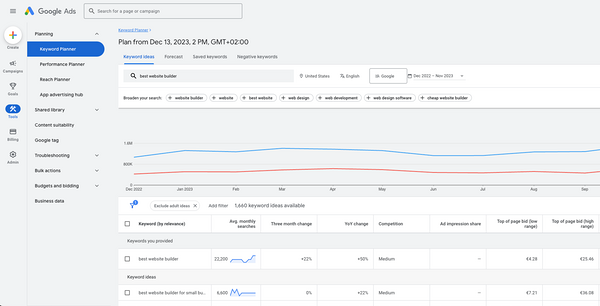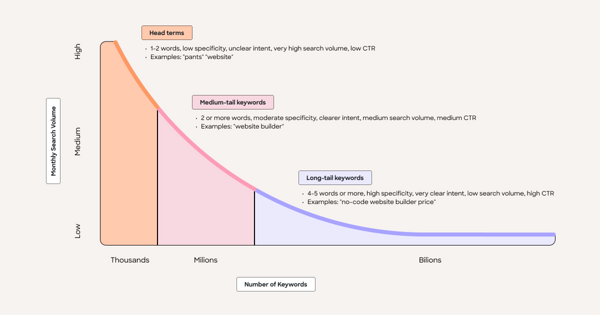- Perform keyword research for PPC;
- Improve your ad performance;
- Optimize your campaigns and match audience intent;
- Measure the performance of your campaigns.
Why keyword research for PPC is important
Keyword research for PPC plays a significant role in optimizing ad spend and ensures that your products, services, or information are presented to the right audience, at the optimal moment, and in the most effective format.In Google Ads, choosing and optimizing ads for the right keywords leads to a higher ad Quality Score. The quality score is calculated based on three components:
- Expected click-through rate (CTR): the likelihood of users clicking on your ads based on your targeting and ad copy.
- Ad relevance: how closely your ad matches your keywords and search intent.
- Landing page experience: how well your landing page answers search intent through its layout, copy, and overall performance.
In other words, a great campaign starts with the right PPC keyword research. Identifying what your audience searches and when leads to cleared ad copy and better landing pages.
Understanding keyword intent
The objective or reason behind a user's search query is keyword intent. It impacts PPC because it establishes the probability that a user will click on your advertisement.You can maximize your return on investment from PPC campaigns by fully understanding and focusing on various forms of keyword intent:
- Informational keywords: the user wants to learn, explore, or understand a topic. (Examples: "how to perform keyword research for PPC")
- Navigational keywords: the user is looking for a specific website or location. Examples include brand names, website names, or specific pages.
- Commercial keywords: the user in the consideration phase of the journey and wants to know more about products or services before buying.
- Transactional keywords: the user is ready to take an action, like making a purchase or completing a transaction.
- Aim for informational keywords to expand your audience and increase brand awareness. Despite their low conversion rate, these keywords appear in many searches, helping you establish credibility and educate potential customers.
- Focus on commercial keywords to increase website traffic and generate leads. These keywords can highlight your value proposition and influence potential customers to choose you over your rivals.
- Bid on transactional keywords if you want to increase sales and revenue. They convert well but are very competitive.
How to perform keyword research for PPC
PPC keyword research is the process of identifying and choosing the phrases that bring in relevant users for your ad campaigns.This process allows you to optimize your budget, achieve your goals, and increase your conversion rate. To perform keyword research for PPC, follow these simple steps:
- Set your campaign goals. What do you want to achieve with your ads? What action do you want users to take? What metrics do you want to track?
- Know your target audience. What needs, problems, or wants do they have? What intent do they have when they perform Google searches? What words or phrases do they use?
- Use keyword research tools. These tools can provide suggestions and information about each keyword's search volume, CPC, difficulty, or trends.
- Estimate your ad spend. The research tools (which we go into more detail below) make it easier to estimate your monthly ad spend and results (clicks, impressions, conversions, CPC, etc.).
- Analyze and select keywords. Choose the keywords that best match your goals, audience, and offer. Take into account the match type relevance, competition, and budget. Create a seed list of primary and secondary keywords for each ad group.
- See what’s already working for your competitors. Use your Google Ads tool or a tool like SemRush (AdClarity) to see what your competitors are bidding on.
- Implement and optimize keywords. Use your focused keywords in ads copy and landing pages. Make sure your messaging matches.
- Monitor and improve your ads. Check your ads constantly to evaluate performance, filter out low-performing keywords, or make text improvements.
Keyword bidding in Google Ads
Google Ads is the most popular ad platform. Most of the PPC keyword research principles that apply to it also work on platforms like Bing, Yahoo, etc (with some particularities).Advertisers bid on specific keywords related to their products or services directly from Google Ads. When users type these keywords into Google's search bar, the ads that are associated with the winning bids appear among the first in the search results.
Businesses or individuals can promote themselves in the Google search engine, through digital banners on various Google partner sites, and YouTube. For this guide, we are only interested in the Google search engine and how promotions work in this space.
Google search campaigns are based on an auction system. This is where different users who want their advertisement displayed on specific searches (for instance, the search for 'keyword research tools') compete using a keyword in exchange for a fee.
Keyword match types on ad platforms
There are several types of keyword matches on ad platforms, such as exact match, phrase match, and broad match.To increase query flexibility without disregarding relevance, Google decided to expand exact match keywords. EEM (Expanded Exact Match) makes room for more ads, taking into consideration keyword variations on the same meaning.
You need to put a keyword in square brackets to set a keyword as an exact match. For example: [high-waisted yoga pants]. This keyword can trigger your ads for searches such as:
- High-waisted yoga pants
- Yoga pants with high waist
Google started incorporating behaviors of Broad Match Modifiers into phrase match in July, 2021. Phrase match keywords give you a wider targeting area than exact match but narrower than broad match. To set a keyword as a phrase match, you must enclose it in quotation marks. For example: “yoga pants for women.” This keyword can trigger your ads for searches such as:
- Cotton yoga pants for women
- Yoga pants for women on sale
They give you the most extensive targeting range, help you attract more traffic to your site, and discover new keyword opportunities relevant to your business. Broad match keywords are simply spelled out in Google Ads. Example: yoga pants. This keyword can trigger your ads for searches such as:
- Women yoga pants
- Yogi pants
- Leggings for yoga
- Yoga pants for women
- Cotton yoga pants online
To correctly use keywords such as exact match, phrase match, or broad match, follow these steps:
- Sign in to your Google Ads account and select your campaign.
- Click on Ad Groups and choose your desired Ad group.
- Click on Keywords and then on the blue plus (+) sign button.
- Type the keywords you want to use with square brackets (exact), quotation marks (phrase), or no symbol (broad), and click Save.
How to organize your PPC keywords
Branded keywords are specific to your brand or company name. Let’s say your brand is "Voog". A branded keyword would be "Voog website builder" or "Voog official website." These types of keywords are used for brand protection and capturing what I like to call "low-hanging fruits" a.k.a. brand-aware leads.
These keywords connect directly to your business and register higher click-through rates and conversions. Since users are actively searching for your brand, competition is usually lower, leading to lower costs.
- Estimated costs: Generally, lower cost per click (CPC).
Generic keywords relate to your products or services but don't include your brand name. They target a wider audience because they lack specificity, which leads to more competition.
For instance, if you sell a website builder solution, a generic keyword might be "website builder service" or "build your first website." Since a lot of companies qualify for this association of terms, CPC will be higher, and conversion rates will not be as high as the ones registered with branded keywords.
The main advantage of targeting generic keywords is reaching more people, some of whom might not even be familiar with your brand. You also reach clients at every stage of the buying cycle, not just those ready to make a purchase.
- Estimated costs: Can vary; typically moderate to high CPC.
Competitor keywords involve targeting the brand names of your competitors. In this case, "Competitor X website builder" qualifies as an example. This type of keyword is effective for capturing users interested in alternative products or for making comparisons, but it comes with a much higher CPC.
From a legal standpoint, bidding on competitor keywords requires careful consideration of market regulations and ethical standards. When done right and fully compliant with the law, targeting competitor keywords results in significant opportunities to present your product.
Such a strategy should also serve as a landing page that compares your service/product with the competitor or shows benefits straight away.
- Estimated costs: moderate to high CPC.
How to improve keyword performance on Google ads
Given that AI (machine learning) is beyond the cognitive capabilities of a human, we recommend spending 95% of the time using bidding strategies that rely on AI.Users performing searches don't always find the right words for the search they started, but Google can identify a user's intent based on their journey.
If the niche you're bidding in has a massive number of searches, use the bidding platform’s machine learning and broad keywords to bid on user intent. We recommend 5-7 ad groups and 5-7 keywords per group to get the best out of the ads platform for each campaign.
Check your website's organic traffic to find which keywords attract your audience. Sync your organic and PPC efforts to cover as many relevant keywords as possible for your business.
Tips to optimize your ads for paid search
Responsive search ads
These ads adapt automatically to display relevant messages to your customers. Most platforms allow you to enter multiple headlines and descriptions and will test various combinations to determine which works best.
Dynamic search ads
These ads fill in the blanks in your keyword-based campaigns by using the content of your website. Because the search engine will create headlines and descriptions based on the query and your website, you don't need to write them.
Call-only ads
Call ads feature your phone number, a call button, and a brief description to entice customers to call your company. They are only available on phones, and the cost is incurred for each call. Find relevant keywords for your products or services using the keyword planner tool, then organize them into ad groups with a similar theme. Incorporate synonyms or variations of your primary keywords into your headlines and descriptions to reduce repetition and boost relevancy.
Use keyword insertion to dynamically update your advertisement text with the keywords that prompted it.
Use the search terms report to find out which searches led to your ads. Then, eliminate any irrelevant, poorly performing, or off-topic queries. Add them as negative keywords to stop your advertisements from appearing for those terms in the future.
Regularly review your lists of negative keywords and eliminate any that could be relevant to your campaigns.
Relevant metrics for PPC keywords and ad campaigns
There are many metrics to follow, but the ones below are crucial when it comes to optimizing PPC performance:This includes the number of monthly searches that contain a specific keyword. Higher search volume doesn’t necessarily equal higher conversion.
For more clarity, you can further categorize keywords according to specificity and buying intent:
- Head terms are one or two-word keywords like "website" or "pants" and often have low buyer intent.
- Medium-tail keywords, like "yoga pants," are more specific and have higher conversion rates.
- Long-tail keywords make up the bulk of all monthly keyword searches. They generally have very low volume but are incredibly specific. Bidding on long-tails results in higher conversion rates.
The competition level shows how many advertisers are bidding on a specific keyword. When the competition is high, so is the cost-per-click (CPC).
Perform competitor analysis using tools like Google Ads Auction Insights. Check competitors’ landing pages and see what they do better, then apply it to your website. Negative LP experiences impact Quality Scores, much like ad rankings, so consider tweaking your landing page and keyword targeting.
We've been taking a lot about intent. It plays a crucial role in delivering relevant content for your users and will influence the type of ads and experiences you create.
You can use ad extensions to keep your ads more in tune with user intent and provide more value. Site links, callouts, or structured snippet extensions allow you to showcase additional product features or benefits.
How to measure the profitability of your PPC campaigns
Most ad platforms allow you to bid according to your business goals (e.g., new paying users, completed purchases, etc.).You need proper conversion tracking in place (with Google Analytics, Google Tag Manager, or other third-party analytics tools) and, if possible, UTM tracking to drill down on your campaigns and keywords. This is a topic in itself, so let’s focus on KPIs for PPC campaigns.
Beyond regular keyword metrics, other KPIs can help you determine the success of your PPC campaigns. We will list two we use, but please note that each industry and product is different, so you must benchmark accordingly.
The simplest way to measure your profitability is by calculating how much you invest into your ads and how much you get out of them. As an e-commerce store or B2C company, you might look to earn at least $5 for each $1 invested.
If your business is earning money over time from the same customers, the calculation becomes more complicated. This is why I strongly recommend using the second profitability calculation.
Correct tracking allows you to measure exactly how much one conversion is worth and how much you earn over time. If you are selling subscription packages or have predictable revenue each month, it might be worth paying more to acquire a customer.
The CAC payback period indicates how long it takes for you to get back the money you invested in ads and when your customers become profitable. For the SaaS industry, the average CAC payback period is over five months.
Tools for PPC keyword research
- Google Keyword Planner provides free-of-charge insights into search volume, competition, and suggested bid estimates. Because it uses data directly from Google’s search engine, it is ideal for Google Ads campaigns.
- Semrush also covers key metrics like search volume, keyword difficulty, and the potential traffic for paid and organic searches.
- Ahrefs provides insights into organic and paid keyword performance. Its Keyword Explorer tool offers data on search volume, difficulty, and traffic potential.
- Answer the Public helps you discover what people are asking about and organizes your keywords into visualizations based on search intent.
- Google Search or Quora are great places to find questions that your target audience is asking.
- Google Trends is a free tool that helps you identify trending topics.
Ready to optimize your PPC campaigns?
PPC keyword research is an ongoing process that ensures your campaigns remain effective and generate meaningful results. This way, you increase the chances of users taking your desired action.
This concludes our guide. We hope it will give you a better understanding of how and when to bid on certain keywords with your PPC campaigns.








_block.png)

_block.png)